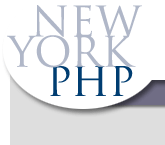 Browse and upload photos of events, at the
NYPHP flickr Group.
Browse and upload photos of events, at the
NYPHP flickr Group.
 Link up with NYPHP at the
PHP LinkedIn Group.
Link up with NYPHP at the
PHP LinkedIn Group.
php meetup
Join Matt Zimmerman, Weizhen Tu and Hans Zaunere as this session examines how PHP fulfills the rapid, reliable and adaptable requirements of the academic enterprise.
PHP in Education, Universities, and Academic Research Intranets
Originally Presented at PHP Conference East 2003
May 27th, 2003
Often noted as PHP's greatest strength, flexible and extensible development is vital to the large and heterogeneous environment of a University. In this session we examine three systems that leverage these benefits. Whether providing a digital archive for international archeology, building on legacy systems to maintain highly sensitive medical research data, or delivering multifaceted views of faculty profiles to the Internet audience, PHP enables the quick construction of new resources and the integration of diverse systems already in use.Join Matt Zimmerman, Weizhen Tu and Hans Zaunere as this session examines how PHP fulfills the rapid, reliable and adaptable requirements of the academic enterprise.
- Matthew Zimmerman, Humanities Computing Group, New York University
Matthew received his M.A. in English Literature from the University of Georgia in 1996 and currently works in the Humanities Computing Group at New York University. The Humanities Computing Group is part of NYU's Information Technology Services and serves as a resource for Humanities faculty who wish to use technology in their teaching or research. Matthew is using PHP and MySQL to develop a digital archive for the Aphrodisias project, an archeological research project being carried out in Turkey by (the) Institute of Fine Arts in cooperation with NYU. - Weizhen Tu, Campus Web Technology, SUNY Upstate Medical University
Weizhen received her Ph.D in engineering from SUNY University at Buffalo. She has been building database-driven Web site for the last three years, first with Perl/Oracle, then with PHP/Oracle/MySQL. She currently works at SUNY Upstate Medical University and has recently completed a PHP/Oracle project - the Upstate Faculty Database System. - Hans Zaunere, President, New York PHP, Senior System Architect, New York University College of Dentistry
As a freelance developer of GPS systems, Hans employed Open Source tools to massage and analyze geophysical data in 1995. While working as a network and systems administrator, he discovered PHP and quickly migrated all modeling and monitoring tools to the web with the aid of Apache and MySQL. Then, after moving to Manhattan to take a position at New York University, Hans formed New York PHP to develop and promote the use of his favorite language.
RELATED PRESENTATIONS

free PHP thumbnail maker CSS & Javascript minify gzip pipeline online API and console
Free API and developer tools console for PageSpeed optimization.

 Click for Details
Click for Details